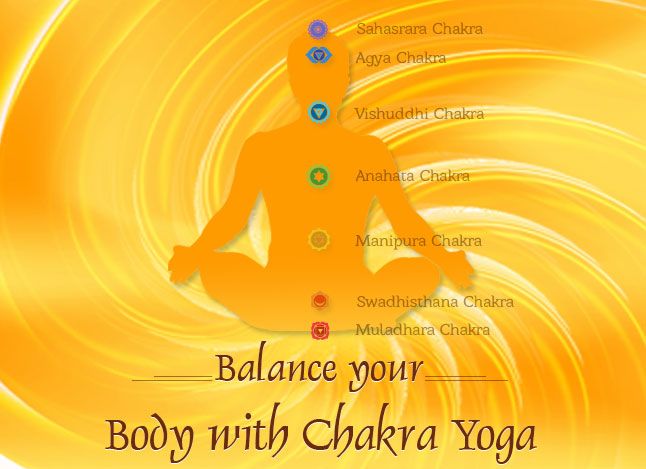
There are 7 Chakras or energy centers in our body through which our vital energy, or “Prana shakti” flows. Blocked energy in these Chakras can often lead to illness so it’s important to understand what each Chakra represents and what we can do to keep this energy flowing freely.
When a chakra, or wheel of energy, is stuck it may be helpful to release the prana (energy) through movement. Yoga postures are a great way to release stale or stuck energy from the body because they invite fresh, vital energy back in through poses and the breath.
Since yoga is both a physical and spiritual practice, yoga poses are not only exercises for your body, but also for your mind, emotions and spirit, making it the perfect practice for balancing your chakras.

Contents
Muladhara Chakra
Element: Earth | Color: Red | Mantra: LAM
Location: Base of the spine between anus and genitals.
The Muladhara Chakra influences the health of the bones, teeth, nails, anus, prostate, adrenals, kidneys, lower digestive functions, excretory functions, and sexual activity. Imbalance in the chakra leads to tiredness, poor sleep, lower back pain, sciatica, constipation, depression, immune related disorders, obesity and eating disorders.
Behavioral Impact of the imbalance: Ungrounded, fear, anger, low self-esteem, insecurity, obsessed with comfort, possessive.
Traits of a Balanced Chakra: Feeling grounded and centered, committed and independent, having energy and vitality, strength and stillness, able to digest foods well.
Postures that Balance Chakra: Grounding into feet poses like Mountain Pose, Side-Angle Pose, Warrior Pose, Standing Forward Bend and Bridge Pose.
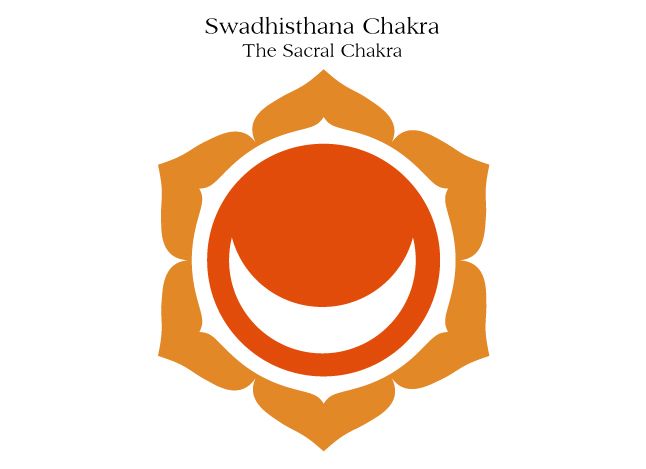
Swadishthana Chakra
Element: Water | Color: Orange | Mantra: VAM
Location: situated at the base of the pubis between the genitals and the sacral nerve plexus.
Swadishthana Chakra deals with the individual’s emotional identity, creativity, desire, pleasure and self-gratification, procreation, and personal relationships. It governs the sexual organs, stomach, upper intestines, liver, gallbladder, kidney, pancreas, adrenal glands, spleen, middle spine, and auto immune system. An imbalanced Swadishthana chakra leads to lower back pain, sciatica, decreased libido, pelvic pain, urinary problems, poor digestion, low resistance to infection and viruses, tiredness, hormonal imbalances and menstrual problems.
Behavioral Impact of Imbalance: Irritability, shyness, guilt, blame, sexual obsession, lack of creativity.
Traits of a Balanced Chakra: Feeling compassionate and friendly, intuitiveness, vitality, having a sense of belonging and humor.
Postures that Balance Chakra: Hip opening poses like Standing Wide Forward, Sitting Wide Forward Bend and Bound Angle Pose.
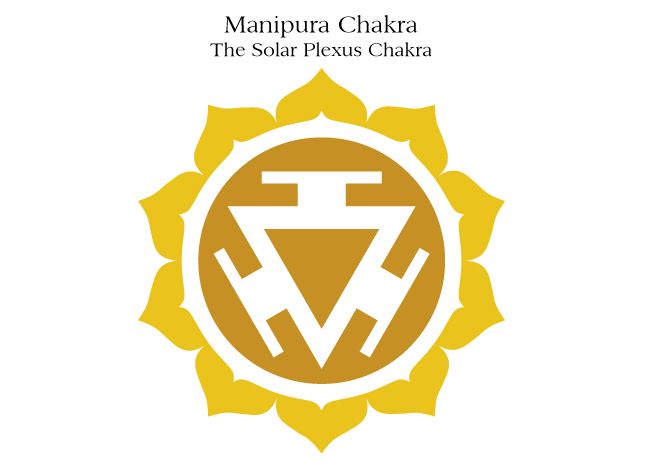
Manipura Chakra
Element: Fire | Color: Yellow | Mantra: RAM
Location: At the level of the umbilicus corresponding to the gastric or solar plexus.
Manipura Chakra deals with a sense of belonging, mental understanding of emotions, and defines self-esteem in an individual. It governs effective functioning of the upper abdomen, gallbladder, liver, middle spine, kidney, adrenals, small intestines and the stomach. Imbalanced Manipura chakra may lead to diabetes, pancreatitis, adrenal imbalances, arthritis, colon diseases, stomach ulcers, intestinal tumors, anorexia/bulimia or low blood pressure.
Behavioral Impact of Imbalance: Lack of self-esteem, timid, depression and fear of rejection, inability to make decisions, judgmental, anger, and hostility.
Traits of a Balanced Chakra: Energetic, confident, intelligent, productive, focused and good digestion.
Postures that Balance Chakra: Heat building poses like Sun Salutation and Warrior pose; backbends like Bow pose, twists like Sitting Half-spinal twist; and abdominal strengthening poses like Boat pose.
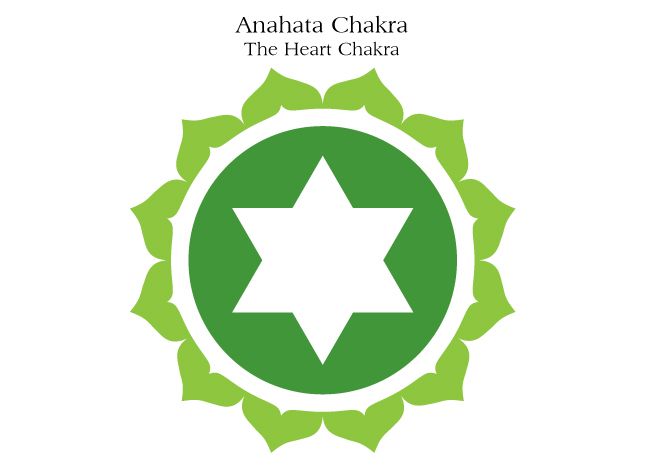
Anahata Chakra
Element: Air | Colors: Green or Pink | Mantra: YAM
Location: On the cardiac plexus in the region of the Heart.
Anahata chakra affects a person’s social identity; and influences traits like trust, forgiveness, unconditional love, wisdom, compassion, and issues of the soul. It deals with the functioning of the heart, rib cage, blood, circulatory system, lungs and diaphragm, thymus gland, breasts, esophagus, shoulders, arms, hands. An imbalance can cause issues related to thoracic spine, upper back and shoulder problems, asthma, heart conditions, shallow breathing, and lung diseases.
Behavioral Impact of Imbalance: Difficulty with love, lack of hope, compassion and confidence, feeling of despair, and mood variations.
Traits of a Balanced Chakra: Feeling of completeness and wholeness, compassionate, empathic, friendly, optimistic, motivated & outgoing.
Postures that Balance Chakra: Chest openers like Camel pose, Cobra pose, Fish pose; and pranayamas like Alternate nostril breathing or Bellow breath.
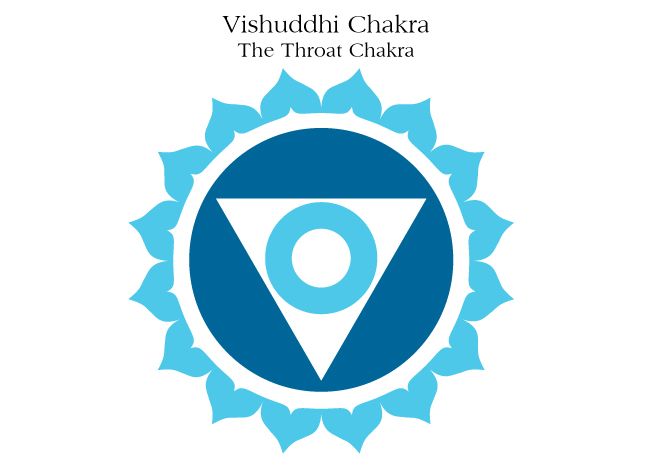
Vishuddhi Chakra
Element: Sound or Ether | Color: Blue | Mantra: HAM
Location: On the level of the throat, the nerve plexus of the pharynx region.
Vishuddhi Chakra deals with personality traits like communication, creativity, faith, truthfulness, self-awareness and expression. It governs the throat, the thyroid and parathyroid gland, trachea, cervical vertebrae, vocal cords, neck & shoulders, arms, hands, esophagus, mouth, teeth, and gums. An imbalanced Vishuddhi chakra causes thyroid dysfunctions, sore throat, stiff neck, mouth ulcers, gum or tooth problems, laryngitis, hearing problems etc.
Behavioral Impact of Imbalance: Shaken faith, indecisiveness, weak will-power, inexpressiveness, lack of creativity, prone to addictions.
Traits of a Balanced Chakra: Creative and expressive, effective communication skills, content, good listener.
Postures that Balance Chakra: Fish pose, Cat stretch, Neck stretches and Supported shoulder stand, Bridge Pose and Plow Pose.
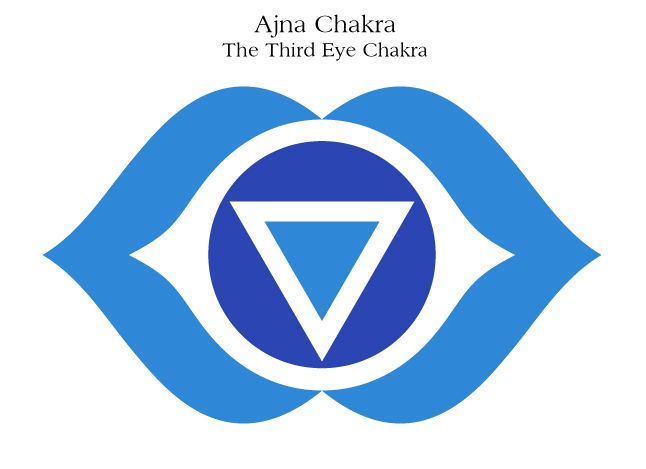
Ajna Chakra
Element: Light | Colors: Indigo | Mantra: AUM or OM
Location: Between the eyebrows (Third Eye).
Ajna Chakra deals with self-awareness, wisdom, intellect, clairvoyance, implementation of ideas, detachment, insight, understanding and intuitive reasoning. It governs the functions of the brain, eyes, ears, nose, pituitary gland, pineal glands and the neurological system. Any imbalance could lead to headaches, nightmares, eyestrain, learning disabilities, panic, depression, blindness, deafness, seizures, or spinal dysfunctions.
Behavioral Impact of Imbalance: Poor judgment, confusion, fear of truth, indiscipline, and concentration issues.
Traits of a Balanced Chakra: Clear thinking, healthy imagination, strong intuition power, concentration and improved focus.
Postures that Balance Chakra: Child’s Pose, meditation, seated Yoga Mudra; and palming the eyes and eye circles.
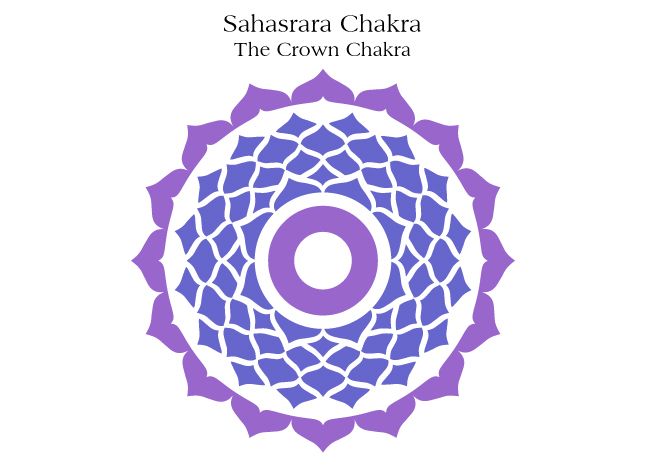
Sahasrara Chakra
Element: Conscience | Colors: Violet or White | Mantra: Silence
Location: Crown of the head.
Sahasrara Chakra influences intuitive knowing, connection to spirituality, integration of mind-body-spirit and conscious awareness. It governs the center of the head and midline above the ears, brain, nervous system, and the pineal gland. Imbalance in the Sahasrara chakra causes chronic exhaustion and sensitivity to light and sound.
Behavioral Impact of Imbalance: Lack of purpose, identity crisis, disbelief in any spiritual practices, or devotion and inspiration, sense of fear and materialistic nature.
Traits of a Balanced Chakra: Feeling at one with the universe, open-mindedness, intelligent, thoughtful, receptive to thought and ideas & overall harmonious personality.
Postures that Balance Chakra: Balancing poses that bring awareness to the body, sitting in Yoga Mudra and meditation.
[“source-Artofliving”]
